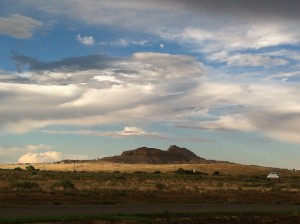I recently returned from the Hopi indian reservation in Northern Arizona. I provide monthly medical services mostly ER and OB coverage at the hospital which is near fist mesa, in Polacca Arizona. This is a very beautiful and remote part of the country with beautiful, kind, and welcoming people. The hospital is a small rural hospital which provides medical care for much of the Hopi and parts of the Navajo reservations. There are three primary landmarks on Hopi; first, second and third mesas, which each have unique historical and spiritual significance. Many Hopi still maintain homes on the tops of the various mesas. The three mesas are some of the oldest continually inhabited regions in the continental United States.
Hopi land is a wonderful place to see and study the manifestation of osteopathic principles. It is interesting to note that Dr. Still the founder of osteopathy spent time with several Native American tribes in the late eighteen hundreds, this likely had some influence on his conception of osteopathic medicine.
At the core of both osteopathy and with in the cosmology of many indigenous cultures through out the world is the principle of holism – the recognition that everything is connected, interrelated, and interdependent. Dr Still the founder of osteopathy once said, “to know a bone in it’s entirety would close both ends of eternity.” We could contemplate and discuss the meaning of this one sentence for a very long time. Much of Dr. Still’s writings point to his deep understanding of holism and the importance he placed on this basic principle in his philosophy and practice of medicine.
In osteopathy we are seeking to do much more than briefly acknowledge the word holistic; we are actually seeking to perceive with all of our senses the sensation of being a living whole human being, fully integrated and harmonized with the world. Many diseases and problems arise out of a sense of isolation, separation, and disharmony with our environment. Many patients find as their perceptions shift from multiplicity and separation to unity and wholeness their physical symptoms improve or resolve, we actually begin to heal and to feel better.
For many of us our senses are primarily organized around the sensation of separation, and multiplicity. We know very well what it feels like to be stressed, afraid, alone, over worked, tired, but what does it feel like to be in our true and natural state of wholeness – complete harmony and synchronization with our surroundings and with the divine? The very idea of wholeness might give rise to just a little bit of joy in our hearts a subtle warm sensation in our chest. If we are able to notice this small and subtle joy, this little warmth and movement around our hearts with out trying to posses it, with out overwhelming it, but just a little attention to it, nurturing it like a new born, it just might start to grow in us and if we are lucky we might start to see and feel ourselves in a new way.
Wholeness is more than an intellectual idea, it is a way of perceiving, it is a way of living; it is the sensation of wellness, peace and harmony, it is our natural state. For any medicine or therapy to be truly holistic it must lead us towards healing and our natural state of wholeness with out creating perceptual tension or isolation. Just a natural movement towards a sense of wellness, peace and harmony is the minimal prerequisite of holistic medicine.


I am new to osteopathy, but am loving its embrace of all the themes and principles that are important to me, especially that we have an inner wisdom that will steer us right.
I currently live in Arizona, and I have yet to visit Hopi-land. It is on my short list of things to do while living here.
I recently met a CST practitioner who also goes to one of the Hopi mesas in order to share that skill with Native practitioners.
That seems like an awesome thing to do, and perhaps, one day….